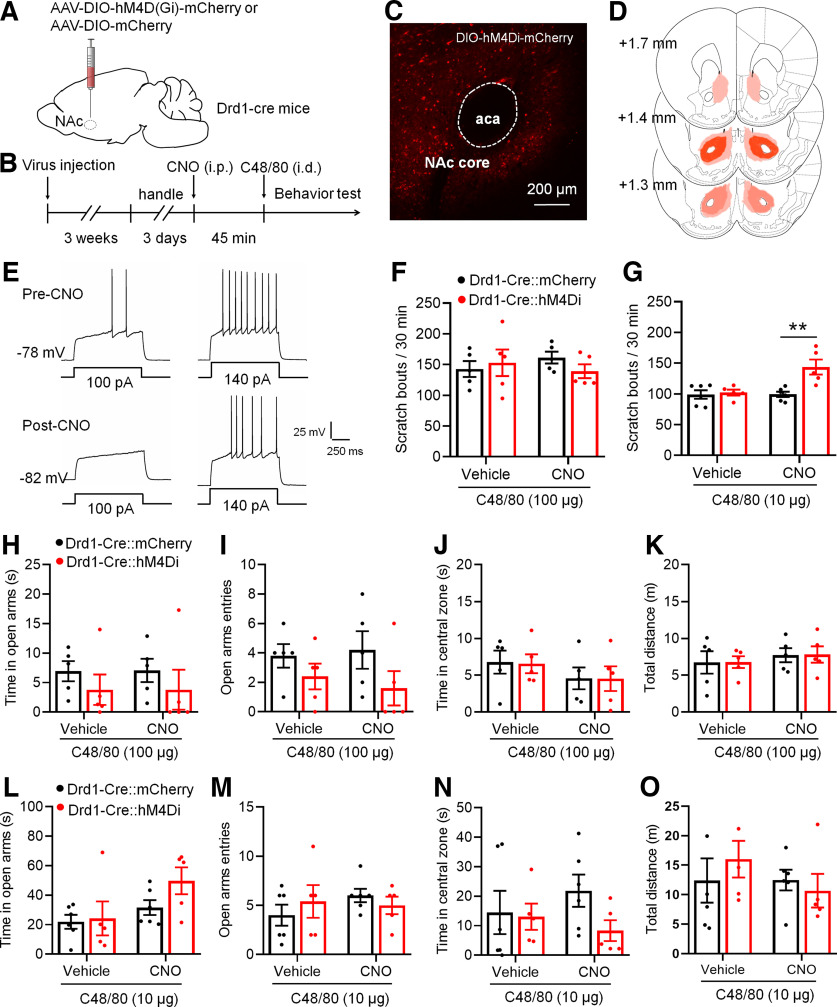Figure 3.
Chemogenetic inhibition of Drd1-MSNs in the NAc core increases C48/80-induced scratching behaviors. A, Schematic illustration of virus injection site in the NAc. The AAV-DIO-hM4Di-mCherry was used for conditional suppression of Drd1-MSNs in Drd1-Cre mice. B, Schematic diagram of the timeline for the experiment. C, Representative brain section shows the expression of AAV-DIO-hM4Di-mCherry in the NAc core. aca, anterior commissure, anterior part. D, Viral spread of AAV-DIO-hM4D(Gi)-mCherry and AAV-DIO-mCherry in Drd1-cre mice. E, Sample traces show the injected currents (+100 and +140 pA)-evoked membrane voltage responses recorded in hM4Di-expressing Drd1-MSNs before and after CNO (5 μm) application. F, Chemogenetic inhibition of Drd1-MSNs in the NAc core does not change the scratching behaviors in mice treated with C48/80 at the dose of 100 µg/50 μl (F(interaction 1,8) = 1.099, p = 0.3251; F(drug 1,8) = 0.02412, p = 0.8804; F(virus 1,8) = 0.1931, p = 0.6719). G, Chemogentic inhibition of Drd1-MSNs in the NAc core enhances the scratching behaviors in mice treated with a lower dose of C48/80 (10 µg/50 μl; F(interaction 1,9) = 8.069, p = 0.0194; F(drug 1,9) = 8.331, p = 0.0180; F(virus 1,9) = 9.858, **p = 0.0119). H, The EMPT shows that inhibition of Drd1-MSNs in the NAc core does not change the time spent in open arms in mice treated with C48/80 (100 µg; F(interaction 1,8) = 0.00156, p = 0.9695; F(drug 1,8) = 0.00156, p = 0.09695; F(virus 1,8) = 1.003, p = 0.3459). I, Same as H for the summary of the open arms entry (F(interaction 1,8) = 0.6857; p = 0.4316, F(drug 1,8) = 0.07619, p = 0.7895; F(virus 1,8) = 2.388, p = 0.1608). J, The OFT shows that inhibition of Drd1-MSNs in the NAc core does not change the time spent in central zone in mice treated with C48/80 (100 µg; F(interaction 1,8) = 0.00249, p = 0.9614; F(drug 1,8) = 1.368, p = 0.2757; F(virus 1,8) = 0.01299, p = 0.9121). K, Same as J for summary of the travel distance (F(interaction 1,8) = 0.00036, p = 0.9852; F(drug 1,8) = 0.4664, p = 0.5139; F(virus 1,8) = 0.0117, p = 0.9165). L, Same as H for results obtained from mice with a lower dose of C48/80 (10 µg) treatment (F(interaction 1,9) = 0.6834, p = 0.4298; F(drug 1,9) = 3.33, p = 0.1013; F(virus 1,9) = 4.310, p = 0.0677). M, Same as I for the open arms entry (F(interaction 1,9) = 0.9605, p = 0.3527; F(drug 1,9) = 0.4269, p = 0.5299; F(virus 1,9) = 0.04306, p = 0.8402). N, Same as J for results obtained from mice with a lower dose of C48/80 treatment (F(interaction 1,9) = 1.951, p = 0.1959; F(drug 1,9) = 0.09541, p = 0.7644; F(virus 1,9) = 1.235, p = 0.2952). O, Same as K for the travel distance (F(interaction 1,9) = 1.191, p = 0.3035; F(drug 1,9) = 1.129, p = 0.3156; F(virus 1,9) = 0.07106, p = 0.7958).

